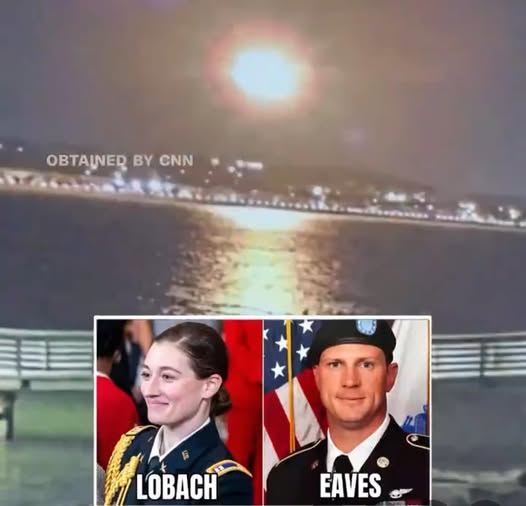Pilot Error Cited in Deadly January Mid-Air Collision Over Washington, D.C.; 67 Lives Lost
WASHINGTON, D.C. — A newly published report has shed devastating new light on the deadly mid-air collision that occurred in January over Washington, D.C., between a military Black Hawk helicopter and a commercial passenger airplane. The incident, which resulted in the tragic loss of 67 lives, has left the nation grappling with the devastating consequences of what investigators are now calling pilot error.
The report, which was detailed in The New York Times on Sunday, reveals critical findings from the investigation conducted by the National Transportation Safety Board (NTSB). The collision, which occurred on January 12, 2025, shocked the nation and raised serious questions about the safety of civilian and military airspace coordination.
A Day of Tragedy
On that fateful day, the military Black Hawk helicopter, piloted by Capt. Rebecca Lobach and her co-pilot, Chief Warrant Officer 2 Andrew Loyd Eaves, was performing a routine training mission over the D.C. area. The commercial aircraft, a regional passenger flight from Washington National Airport, was also en route, carrying 61 passengers and crew members.
According to the newly released investigation report, Capt. Lobach and Chief Warrant Officer Eaves were flying in a congested airspace with limited visibility due to weather conditions. The collision occurred at approximately 2:18 p.m., when both aircraft became unknowingly converged in the same airspace.
While the helicopter was part of a military training exercise, the commercial airplane was nearing its descent into Washington National Airport, leading to a deadly collision at an altitude of approximately 5,000 feet. Both aircraft were destroyed in the crash, and all 67 individuals aboard both planes were killed instantly.
Pilot Error Identified
The NTSB report confirms that pilot error was the primary factor behind the deadly crash. Investigators found that Capt. Lobach and Chief Warrant Officer Eaves did not properly adhere to the protocols for navigating congested airspace, leading to a critical miscommunication with air traffic control and a lack of awareness of the position of the commercial flight.
In addition, the investigation highlighted inadequate coordination between military and civilian aviation authorities, as well as limited real-time communication between air traffic control centers and military operations during the event.
According to a statement from the NTSB, the incident was exacerbated by poor visibility and failure to follow prescribed flight safety procedures. This lack of situational awareness contributed to the failure to avoid the collision in time.
A Nation in Shock
The crash has devastated the families of the victims, including the families of both the military and civilian crew members and passengers who lost their lives that day. As of Sunday morning, many loved ones have shared their heartbreak on social media and through interviews, calling for changes to airspace safety protocols to prevent such a tragedy from occurring again.
“The pain is unbearable,” said Susan Evans, the widow of one of the civilian passengers. “To think that this was caused by something that could have been prevented, it’s hard to accept.”
Authorities have expressed their deepest condolences to the families of those lost, and President Joe Biden has ordered an official review of airspace safety procedures to prevent similar incidents in the future.
In a statement released on Sunday, the White House said:
“We are deeply saddened by the tragic loss of life in the January mid-air collision. This tragedy has left an indelible mark on the hearts of the nation. Our thoughts are with the families of the victims, and we will continue to work with all relevant agencies to ensure that the lessons learned from this investigation lead to improved safety measures.”
Fallout and Response
The families of the victims are now pushing for stricter regulations to improve the coordination between military and civilian air operations, as well as a reevaluation of the technology and communications systems used to track aircraft in such high-density airspace.
The Federal Aviation Administration (FAA) and Department of Defense have pledged to review the recommendations in the report and take immediate action to improve flight safety, especially in highly congested areas like the D.C. airspace.
Senator Tim Kaine of Virginia, whose state includes Washington, D.C., has already introduced legislation to increase funding for improved air traffic control technology and inter-agency communication.
“This was a preventable tragedy, and we owe it to the victims and their families to do everything in our power to ensure it never happens again,” Senator Kaine said.
The Investigation Continues
While the NTSB has concluded its investigation into the causes of the crash, the investigation into possible further violations of airspace protocols is ongoing. Capt. Lobach’s and Chief Warrant Officer Eaves’s actions are under review, and military officials are investigating whether any disciplinary actions will be taken.
Additionally, investigators are working with the FAA and the Department of Defense to enhance existing regulations and develop more robust training programs for pilots operating in shared airspace.
As the investigation continues, officials are urging anyone with relevant information to come forward. The NTSB has also promised to release any additional findings that could further enhance safety measures for both military and civilian aviation.
